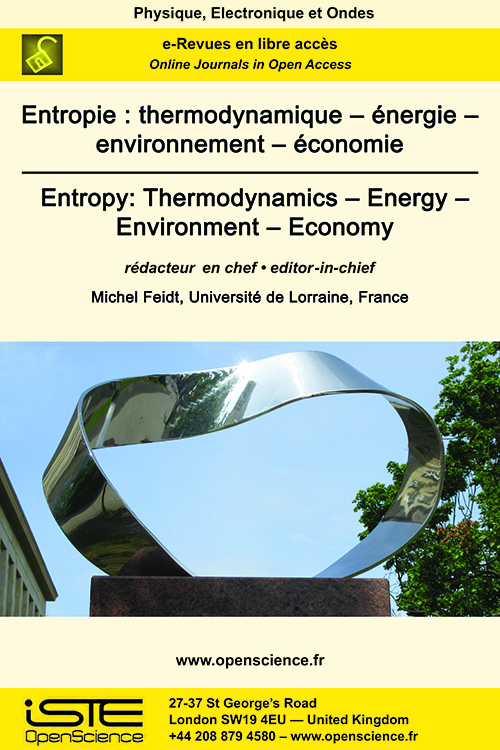

Physics > Home > Entropy: Thermodynamics – Energy – Environment – Economy > Issue
Le volume 2 du projet Lîla Entropie engage véritablement les fondations théoriques d’un statut géométrique de l’entropie ; statut susceptible d’être exempté de toutes statistiques. Telle est la finalité à terme du travail de Philippe Riot qui interroge, par le biais de la théorie des nombres et dans deux articles complémentaires, non pas l’usage du temps pour parler de la dynamique mais l’usage de l’opérateur standard de succession pour parler du temps qui passe. L’ordre nouveau qui émerge de l’analyse relèvera désormais de celui attaché à l’ombilic des mathématiques : la fonction zêta. Celle-ci devenant de fait aussi l’ombilic de la physique des systèmes complexes et intriqués, la signification de zêta comme nouvelle horloge sera explicitée dans le volume 3 du projet Lîla Entropie.
The purpose of this note is to report as closely as possible some aspects of the mathematical work of Cédric Villani on Boltzmann equations and its avatars. This approach is based on a selection by the author of "copied and pasted" of the chapters of an article written by the mathematician published in volume XV of the Poincaré Institute seminars on Time between pages 17 to 75 bearing the title " (Ir)reversibility and entropy”. Due to lack of availability, this note could not be taken care of by the academician, which is why it was assumed by one of the editors. Its sole purpose of the "text pasting" is to convince the engineer or physicist reader to immerse themselves in the original text and in the many writings and conferences of Cédric Villani. This note should make it possible to understand from which solid base can operate epistemological revisions of a thought about time.
The Riemann zeta function is identified on the one hand as a substitute for the equality predicate and on the other hand as a model of continuity. Thanks to this second interpretation, Riemann’s conjecture addressing the distribution of non-trivial zeros of this function is not resolved here, it is dissolved in the sense that its statement turns out to be equivalent to an essential axiom of the forcing technique, namely the Martin’s axiom. For practical reasons of length of the text, the restitution of the study of this function is divided into two parts. The first focuses on the interpretation of the zeta function as a logical interpolator while the second part will be devoted to the topological and ordinal study to understand the meaning of the Riemann statement concerning the location of nontrivial zeros of this function. The interpretation of the function resulting from the study, the main conclusions of which are presented in both articles, explains the central role played by this function not only in mathematics, but also in many other scientific fields, in particular to study the behavior of complex systems.
This note introduce the definitions of ordinal and cardinal equipotent as well as a first classification of infinite countable sets with a regular and uniform character.
Whereas the part 1 sentence attributed to Heraclitus « εν και παν » is a whole merit of being revisited. The significance of the Riemann zeta function ζ emerges using an ordinal reading of this function. In this context, it is important to complete the basic axioms attached to ZFC set theory (Zermelo-Fraenckel with axiom of choice) in order to precisely characterize the cardinality of the continuum. The very definition of the function justifies retaining Martin’s axiom (allowing the rules of infinite combinatorics to be extended beyond the threshold of the smallest uncountable ordinal), the simplest forcing axiom which avoids any argument from metamathematical nature. It then turns out that this is reformulated in an equivalent way like Riemann’s statement on the distribution of its non-trivial zeros.
To overcome the lack of astronomical data on the first conditions of the expansion of the universe, a model compatible with the fundamental principle of cosmology allows to describe the first conditions of the expansion of the universe by a state function that defines the entropy through the transformation of the local curvature of the space-time. The consideration of matter, energy and radiation in the model allows to describe the first conditions necessary for its transformation after its instantaneous dislocation by the simultaneous expansion of the basic elements of the initial space. The model elucidates the uniform distribution of matter 380,000 years after the start of expansion and leads to the identify the origin of gravity.

2025
Volume 25- 6
Issue 12024
Volume 24- 5
Special issue LILA 22023
Volume 23- 4
Issue 12022
Volume 22- 3
Issue 12021
Volume 21- 2
Special issue2020
Volume 20- 1
Issue 1